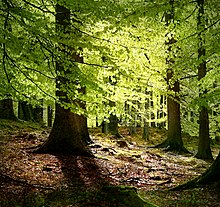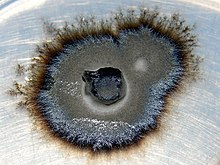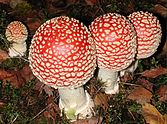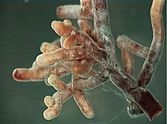菌根
菌根(英語:mycorrhiza)是維管束植物的根與真菌組成的共生關係體,可協助植物吸收水分與養分[1];該關係一般是互利共生的,但偶爾是弱致病性的[2]。菌根在土壤生物學和土壤化學中具有重要作用。
在菌根關係體中,真菌定殖於宿主植物根的方式,有的是內生菌根,如叢枝菌根真菌(AMF 或 AM),其菌絲體會侵入根部皮層細胞內部;有的是外生菌根,其菌絲體不穿透根部皮層細胞內部,只在細胞壁之間生長延伸;亦有外內生菌根,兼具兩者的一些型態特徵或生理特性。
菌根英語 mycorrhiza 之語源為希臘語:μυκός,mykós,"fungus",和 ρίζα,riza,"root" [3]。
發現[編輯]
人們至少在19世紀中期就已經知道了真菌能與植物根部形成連接,但是早期的發現者僅僅記錄了這一現象,卻並沒有進一步研究這兩種生物的關係。[4]該共生現象最早在1879-1882年由弗朗齊歇克·卡緬斯基進行了描述,[5]後來阿爾伯特·伯恩哈德·弗蘭對其進行了進一步研究,並在1885年提出了菌根的概念。[6]
菌根的產生[編輯]
從距今約4億年前的萊尼埃燧石層中出土的植物化石中就已經出現了菌根。[7]
菌根廣泛存在於已發現的92%的植物科中(80%的植物種),[8]其中叢枝菌根是植物界裡最主要以及最原始的共生形式。[8][9]叢枝菌根的結構和有記錄的第一塊化石中的結構高度相似,[7]它們都具有內生菌根結構。[8]
菌根的種類[編輯]

菌根通常被分為外生菌根(ectomycorrhizas)和內生菌根(endomycorrhizas)兩大類,這兩類的區別在於,外生菌根的菌絲不會穿透植物根部細胞,而內生菌根的菌絲會穿透植物細胞的細胞壁,並陷入其細胞膜。[10][11]內生菌根包括叢枝(arbuscular)、杜鵑花類(ericoid)、和蘭科(orchid)菌根。漿果鵑類菌根(arbutoid mycorrhizas)可以被分為內外生菌根(ectoendomycorrhizas)。水晶蘭類菌根(Monotropoid mycorrhizas)自成一類。
內生菌根(Endomycorrhiza)[編輯]
由於內生菌根種類各異,人們將其細分為了叢枝菌根、杜鵑花類菌根、漿果鵑類菌根、水晶蘭類菌根和蘭科菌根[12]叢枝菌根(arbuscular mycorrhiza, AM;舊稱 囊叢枝菌根 vesicular-arbuscular mycorrhizas, VAM)的菌絲進入了植物細胞內部,產生氣球狀(囊泡)或二叉分支狀(叢枝)結構。菌絲不會穿透植物的原生質體,但會陷入植物細胞膜中。叢枝結構能夠極大增加菌絲和胞質的接觸面積,這樣有利於二者營養傳輸。
只有球囊菌門的真菌才能產生叢枝菌根。有化石證據[7]與DNA定序結果[13]表明,該共生結構至少在4-4.6億年前的泥盆紀、當世界上最早的陸地植物出現時就已同時出現。叢枝菌根在約85%的植物科中都有發現,其中包括許多作物。[8]叢枝菌根菌絲能夠產生糖蛋白球囊黴素,球囊黴素是土壤中碳儲存的主要形式之一。叢枝菌根真菌(可能)幾百萬年來都是無性生殖,但每個真菌都可能會同時具有幾個不同來源的細胞核,此現象稱為異核現象。[14]
外生菌根(Ectomycorrhizas, EcM)[編輯]

外生菌根(Ectomycorrhizas,或簡稱EcM)通常形成於約10%的植物科中,形成外生菌根的植物一般都是木本植物,如樺木科的樺樹、龍腦香科的龍腦香樹、桃金孃科的桉樹、山毛櫸科的橡樹、松科的松樹以及 薔薇科的玫瑰。[8] families, orchids,[15]形成外生菌根的真菌屬於擔子菌門、子囊菌門和接合菌門。有些外生菌根真菌,如許多疣柄牛肝菌屬(Leccinum)和乳牛肝菌屬(Suillus)的真菌,只能與某一特定植物屬的植物形成共生體,而如鵝膏菌屬(Amanita)等真菌則能與許多不同種類的植物形成菌根。[16]一棵樹可能同時會和至少15種外生菌根真菌形成菌根。[17]外生菌根真菌有數千個物種,它們能在超過200個植物屬中形成菌根。有保守估計認為,世界上的外生菌根真菌物種可能有大約7750種,但考慮到可能的未知的真菌門類,最終的物種估計數值可能會在20000到25000之間。[18]
外生菌根會形成包裹根尖的菌鞘(fungal mantle,又稱菌氈),以及包裹植物根部皮層內部細胞的哈氏網。在某些情況下菌絲也會穿透植物細胞,這種情況下的菌根叫做內外生菌根(ectendomycorrhiza)。在根外,外生菌根表生菌絲會在土壤和植物碎屑之間形成巨大的網絡。
營養物質可以通過真菌網絡在不同的植物間進行傳遞。紙皮樺和花旗松之間的碳傳遞能夠促進生態系統的演替。[19] 外生菌根真菌雙色蠟蘑Laccaria bicolor能夠引誘並殺死彈尾蟲以獲取氮元素,其中部分氮可能會再被轉送給菌根植物。Klironomos和Hart研究發現,接種了雙色蠟蘑的北美喬松所獲取的氮有高達25%是從彈尾蟲處獲取的。[20][21]
雙色蠟蘑的基因組序列是人們所發表的第一個有代表性的共生真菌基因組序列。[22]該菌基因組中有多個多基因族序列的出現,這暗示雙色蠟蘑可能是通過基因複製來適應共生關係的。在外生菌根根尖處,編碼起共生調節作用的分泌蛋白的譜系特徵性基因的表達均出現了上調,這暗示該基因可能會在共生體的交流上扮演重要角色。雙色蠟蘑缺少降解植物細胞壁成分(如纖維素、半纖維素、果膠和果膠酸鹽)的基因,這避免了真菌在定殖根部時會降解宿主細胞。相反的是,雙色蠟蘑擴大了編碼水解細菌和微生物群多糖與蛋白的多基因族。這一基因組分析揭示了菌根真菌腐生營養和活體營養的雙營養生活方式,該生活方式能夠保證真菌在土壤和植物根內都能生存。
杜鵑花類菌根(Ericoid mycorrhiza)[編輯]

杜鵑花類菌根是第三類在生態上具有較重要意義的菌根,它們的生活史有一個簡單的胞內生存的階段,其間該類真菌會在細胞最外層包裹緻密的菌絲。杜鵑花類菌根真菌沒有periradical階段,而它們的胞外階段(extraradical phase)所產生的菌絲十分稀疏,不會十分深入根系周圍的土壤。此外該類真菌可能會形成子實體(通常為小杯狀),但是目前人們對它們的繁殖機理還少有研究。[11]
杜鵑花類菌根還具有腐生營養的能力,這可以使與它們共生的植物能夠獲取到來自非已分解物質的營養。[24]
漿果鵑類菌根(Arbutoid mycorrhiza)[編輯]
該種菌根存在於杜鵑花科的草莓樹亞科,但它和杜鵑花科菌根並不相似,反而和外生菌根在功能和參與形成菌根的真菌種類上都十分相像。[來源請求]它和外生菌根的區別在於,漿果鵑類菌根的部分菌絲會穿透植物根部細胞,成為內外生菌根。[來源請求]
水晶蘭類菌根(Monotropoid mycorrhiza)[編輯]
該種菌根出現於杜鵑花目的水晶蘭科,以及蘭科的幾個屬內。這些植物是異養或混合營養的,它們從真菌處獲取碳。因此該菌根關係並不是互利共生的。[來源請求]
蘭科菌根[編輯]
所有的蘭科植物在生活史的某些階段都會成為行菌異營,並與真菌形成蘭科菌根[25]。這些真菌的菌絲會穿透植物根部細胞,形成稱為菌絲團(pelotons)的典型捲曲狀結構[26]。
共生生物的動態響應[編輯]
菌根真菌能與大多數植物的根形成共生關係。在該共生關係下,植物本身以及被真菌定殖的根部,都屬於菌根的一部分。雖然目前還少有研究關於植物和真菌的菌根關係的具體種類,但目前已研究的植物中,有95%的科都受益於或依賴菌根。蘭科植物若缺少合適的菌根真菌與之共生就會死亡,甚至無法萌發。[27]
最近有關於北方針葉林外生菌根類植物的研究發現,菌根真菌和植物的關係可能遠不只互利共生那麼簡單。該研究發現菌根真菌會在氮匱乏的情況下從植物根系中獲取並囤積氮。研究人員認為,有些菌根會根據周圍植物及菌根環境的變化來對營養分配做出調節,該新的模型可能會解釋為什麼菌根不會緩解植物的氮匱乏狀況,以及為什麼在缺氮的情況下,原本具有菌根和非菌根根系的植物會突然都變成含菌根的根系。[28]
糖分-水/礦物交換[編輯]
菌根的互利共生關係能夠幫助菌根真菌更直接地獲取碳水化合物,如葡萄糖和蔗糖。[9]碳水化合物會從植物葉片轉移到根部,進而再轉移給植物的合作者真菌。同時,植物會得益於真菌菌絲體對水和礦物質的更高吸收容量,這是因為真菌菌絲表面積更大,菌絲更細更長,能夠獲取植物養分耗竭區(nutrient depletion zone)以外的礦質元素提供給植物,提高植物的礦物吸收容量。[29]
沒有菌根的植物可能會無法吸收不容易轉移的營養元素,常見例子有常量營養素磷酸根和微量營養素鐵。在粘土質或極端pH的土壤中,營養元素一般較難轉移,但是菌根真菌的菌絲體能夠貯存大量該類營養素,並提供給植物。[30]因此,儘管不以土壤為磷源,很多植物還是能夠獲取磷元素。元素固定還有一種方式:它們可能會被封閉在較難分解的有機質(如木頭)中。有些菌根真菌能夠直接分解這些有機物,釋放被封閉的營養元素,並將它們轉運給植物。比如在一些貧瘠的森林中,菌根能夠直接分解落葉碎屑獲取磷及其他營養元素,從而避免了從土壤中獲取。[31]一種能夠代替刀耕火種的雨林耕作模式Inga alley cropping,[32]就是藉助Inga樹根系的菌根來防止磷元素被雨水沖走的。[33]
在一些更複雜的關係中,菌根真菌並不是只積累不易運輸的營養元素,它們還能通過菌根網絡將單個植株連接起來形成地下菌絲網絡,在植物之間直接運輸水、碳以及其他營養物質。[34]
一種叫做Suillus tomentosus的擔子菌門真菌,能以美國黑松(Pinus contorta var. latifolia)為宿主,形成一種帶有小瘤的外生菌根。這種結構可以作為固氮細菌的宿主,從固氮菌處獲取大量氮,從而使得美國黑松能夠在貧瘠的土地上生存。[35]
機制[編輯]

菌根的吸收機制有物理性的也有化學性的。從物理角度而言,大部分菌根菌絲都比植物最細的根要細,表面積更大,因此它們能夠深入植物根與根毛無法進入的地方,吸收大量營養物質。從化學角度而言,真菌細胞膜功能與成分與植物的不同。比如,真菌可能會分泌有機酸來溶解離子,分泌螯合劑來螯合離子,亦或者是通過離子交換將離子從土壤礦物上分離下來。[36]在營養貧瘠的土壤中,菌根對植物尤其有幫助。[37]
抗病、抗旱、耐鹽性與菌根的相關性[編輯]
菌根植物通常更抗病(如由土壤病原體引起的疾病)。AMF與諸如土壤真菌、細菌等在內的土壤生物變量都有顯著相關性[38]。此外,AMF還與土壤水含量有相關性,但與土壤團聚體穩定性沒有相關性。[39][40]AMF對土壤乾旱也有抗性。[41][42][43] 叢枝菌根真菌能夠減輕土壤鹽脅迫,有助於植物生長和繁殖。儘管鹽脅迫對叢枝菌根真菌有消極影響,仍然有很多研究發現菌根植物在鹽脅迫環境下的生長會有所改善。[44]
抗蟲性[編輯]
最近研究表明,植物能夠通過菌根形成的地下網絡來傳遞預警信號。[45][46] 被蚜蟲攻擊後,該植物會傳遞信號給其他植物,分泌揮發性有機物(VOCs)來吸引害蟲的天敵,該VOC還能保護其他植物免受害蟲侵擾。[45]此外,當食草動物取食植物時,該機理還會防止植物碳的重分布,以免影響真菌生長。[45]
貧瘠土中的定殖[編輯]
在貧瘠土和培養基中生長的植物往往長勢較差,因為在這些環境下,它們沒有菌根輔助吸收礦物和水[47]。缺乏菌根真菌還會減緩演替早期或退化地區植物的生長 [48]。向貧瘠土中引入外來菌根植物會使本地植物的生長處於不利地位[49]。
抗毒性[編輯]
在含大量重金屬的土壤中,真菌能夠起到保護植物的作用。在多個重金屬污染地區,接種了Pisolithus tinctorius的松樹都生長良好,並表現出了對污染物的高耐受性。[50]有研究發現褐環乳牛肝菌對鋅有不同的耐受性。另一研究發現,抗鋅真菌Suillus bovinus能使樟子松也具有抗性。[49]
另見[編輯]
- 菌根真菌與土壤碳儲備
- 氣候變化對植物多樣性的影響
- 黏膠層 - 為真菌創造共生環境的物質
- 根瘤菌 - 固氮細菌
參考文獻[編輯]
- ^ Kirk, P. M.; Cannon, P. F.; David, J. C. & Stalpers, J. Ainsworth and Bisby’s Dictionary of the Fungi 9th. Wallingford, UK: CAB International. 2001.
- ^ Johnson, NC; Graham, JH; Smith, FA. Functioning of mycorrhizal associations along the mutualism–parasitism continuum. New Phytologist. 1997 [2017-03-10]. doi:10.1046/j.1469-8137.1997.00729.x. (原始內容存檔於2017-08-18).
- ^ Frank, A. B. Über die auf Würzelsymbiose beruhende Ehrnährung gewisser Bäum durch unterirdische Pilze. Berichte der Deutschen Botanischen Gesellschaft. 1885, 3: 128–145 (德語).
- ^ Rayner, M. Cheveley. Obligate Symbiosis in Calluna vulgaris. Annals of Botany. 1915, 29 (113): 97–134 [2017-03-10]. (原始內容存檔於2021-04-11).
- ^ Kamieński, F. (1882). "Les organes végétatifs de Monotropa hypopitys L.". Mémoires de la Société nat. des Sciences naturelles et mathém. de Cherbourg, ser. 3, tom. 24. (Republished and translated, in: Berch SM, Massicotte HB, Tackaberry LE. 2005. Re-publication of a translation of 'The vegetative organs of Monotropa hypopitys L.' published by F. Kamienski in 1882, with an update on Monotropa mycorrhizas. (頁面存檔備份,存於網際網路檔案館) Mycorrhiza 15:323-332.)
- ^ Frank, A.B. Über die auf Wurzelsymbiose beruhende Ernährung gewisser Bäume durch unterirdische Pilze. Ber. Deutsch. Bot. Gesells. 1885, 3: 128–145.
- ^ 7.0 7.1 7.2 Remy W; Taylor TN; Hass H; Kerp H. 4 hundred million year old vesicular-arbuscular mycorrhizae. Proc. Natl. Acad. Sci. U.S.A. 1994, 91 (25): 11841–11843. Bibcode:1994PNAS...9111841R. PMC 45331
 . PMID 11607500. doi:10.1073/pnas.91.25.11841.
. PMID 11607500. doi:10.1073/pnas.91.25.11841.
- ^ 8.0 8.1 8.2 8.3 8.4 Wang, B.; Qiu, Y.L. Phylogenetic distribution and evolution of mycorrhizas in land plants (PDF). Mycorrhiza. 2006, 16 (5): 299–363 [2008-01-21]. PMID 16845554. doi:10.1007/s00572-005-0033-6.[永久失效連結]
- ^ 9.0 9.1 Harrison MJ. Signaling in the arbuscular mycorrhizal symbiosis. Annu Rev Microbiol. 2005, 59: 19–42. PMID 16153162. doi:10.1146/annurev.micro.58.030603.123749.
- ^ Harley, J.L. and S.E. Smith 1983. Mycorrhizal symbiosis (1st ed.). Academic Press, London.
- ^ 11.0 11.1 Allen, Michael F. 1991. The ecology of mycorrhizae. Cambridge University Press, Cambridge.
- ^ 。Peterson, R. L.; Massicotte, H. B. & Melville, L. H. Mycorrhizas: anatomy and cell biology. National Research Council Research Press. 2004. ISBN 978-0-660-19087-7. (原始內容存檔於2007-12-25).
- ^ Simon, L.; Bousquet, J.; Lévesque, R. C.; Lalonde, M. Origin and diversification of endomycorrhizal fungi and coincidence with vascular land plants. Nature. 1993, 363 (6424): 67–69. Bibcode:1993Natur.363...67S. doi:10.1038/363067a0.
- ^ Hijri, M.; Sanders, IR. Low gene copy number shows that arbuscular mycorrhizal fungi inherit genetically different nuclei. Nature. 2005, 433 (7022): 160–163. Bibcode:2005Natur.433..160H. PMID 15650740. doi:10.1038/nature03069.
- ^ Orchids and fungi: An unexpected case of symbiosis. American Journal of Botany. July 12, 2011 [24 July 2012]. (原始內容存檔於2011-07-15).
- ^ den Bakker, Henk C.; Zuccarello, G. C.; Kuyper, TH. W.; Noordeloos, M. E. Evolution and host specificity in the ectomycorrhizal genus Leccinum (PDF). New Phytologist. 2004, 163: 201–215. doi:10.1111/j.1469-8137.2004.01090.x. (原始內容 (PDF)存檔於2011-07-24).
- ^ Saari, S. K.; Campbell, C. D.; Russell, J.; Alexander, I. J.; Anderson, I. C. Pine microsatellite markers allow roots and ectomycorrhizas to be linked to individual trees (PDF). New Phytologist. 2005, 165 (1): 295–304. PMID 15720641. doi:10.1111/j.1469-8137.2004.01213.x.[失效連結]
- ^ Rinaldi, A.C.; Comandini, O.; Kuyper, T.W. Ectomycorrhizal fungal diversity: separating the wheat from the chaff (PDF). Fungal Diversity. 2008, 33: 1–45 [2017-03-10]. (原始內容 (PDF)存檔於2011-07-24).
- ^ Simard, Suzanne W.; Perry, David A.; Jones, Melanie D.; Myrold, David D.; Durall, Daniel M. & Molina, Randy. Net transfer of carbon between ectomycorrhizal tree species in the field. Nature. 1997, 388 (6642): 579–582 [2017-03-10]. doi:10.1038/41557. (原始內容存檔於2011-05-25).
- ^ Fungi kill insects and feed host plants (頁面存檔備份,存於網際網路檔案館) BNET.com
- ^ Klironomos, J. N.; Hart, M. M. Animal nitrogen swap for plant carbon. Nature. 2001, 410 (6829): 651–652. PMID 11287942. doi:10.1038/35070643.
- ^ Martin, F.; Aerts, A.; et al. The genome of Laccaria bicolor provides insights into mycorrhizal symbiosis. Nature. 2008, 452 (7183): 88–92. Bibcode:2008Natur.452...88M. PMID 18322534. doi:10.1038/nature06556.
- ^ Midgley, DJ; Chambers, SM; Cairney, JWG. Spatial distribution of fungal endophyte genotypes in a Woollsia pungens (Ericaceae) root system. Australian Journal of Botany. 2002, 50 (5): 559–565. doi:10.1071/BT02020.
- ^ Read, D. J. & Perez-Moreno, J. Mycorrhizas and nutrient cycling in ecosystems—a journey towards relevance?. New Phytologist. 2003, 157 (3): 475–492. doi:10.1046/j.1469-8137.2003.00704.x.
- ^ McCormick, M. K.; Lee Taylor, D.; Juhaszova, K.; Burnett, R. K.; Whigham, D. F.; O』Neill, J. P. Limitations on orchid recruitment: not a simple picture. Molecular Ecology. 2012, 21: 1511–1523. PMID 22272942. doi:10.1111/j.1365-294X.2012.05468.x.
- ^ Smith, S. E.; Read, D. J.; Harley, J. L. Mycorrhizal symbiosis 2nd. San Diego, Calif.: Academic Press. 1997. ISBN 0126528403. OCLC 35637899.
- ^ Trappe, J. M. Phylogenetic and ecologic aspects of mycotrophy in the angiosperms from an evolutionary standpoint. Ecophysiology of VA Mycorrhizal Plants, G.R. Safir (EDS) (Florida: CRC Press). 1987.
- ^ Franklin O; Näsholm T; Högberg P; Högberg MN. Forests trapped in nitrogen limitation - an ecological market perspective on ectomycorrhizal symbiosis.. New Phytol. 2014, 203 (2): 657–66. PMID 24824576. doi:10.1111/nph.12840.
- ^ Selosse MA; Richard F; He X; Simard SW. Mycorrhizal networks: des liaisons dangereuses?. Trends Ecol Evol. 2006, 21 (11): 621–628. PMID 16843567. doi:10.1016/j.tree.2006.07.003.
- ^ Li H; Smith SE; Holloway RE, Zhu Y; Smith FA. Arbuscular mycorrhizal fungi contribute to phosphorus uptake by wheat grown in a phosphorus-fixing soil even in the absence of positive growth responses. New Phytol. 2006, 172 (3): 536–543. PMID 17083683. doi:10.1111/j.1469-8137.2006.01846.x.
- ^ C.Michael Hogan. 2011. Phosphate. Encyclopedia of Earth. Topic ed. Andy Jorgensen. Ed.-in-Chief C.J.Cleveland. National Council for Science and the Environment. Washington DC (頁面存檔備份,存於網際網路檔案館)
- ^ Elkan, Daniel. Slash-and-burn farming has become a major threat to the world's rainforest The Guardian 21 April 2004
- ^ rainforestsaver.org: What is Inga alley cropping? 網際網路檔案館的存檔,存檔日期2011-11-01.
- ^ Simard, S.W.; Beiler, K.J.; Bingham, M.A.; Deslippe, J.R.; Philip, L.J. and Teste, F.P. 2012. "Mycorrhizal networks: Mechanisms, ecology and modeling". "Fungal Biology Review" 26: 39-60
- ^ Paul, L.R.; Chapman, B.K.; Chanway, C.P. Nitrogen Fixation Associated with Suillus tomentosus Tuberculate Ectomycorrhizae on Pinus contorta var. latifolia. Annals of Botany. 2007, 99 (6): 1101–1109 [2017-03-10]. PMC 3243579
 . PMID 17468111. doi:10.1093/aob/mcm061. (原始內容存檔於2012-11-28).
. PMID 17468111. doi:10.1093/aob/mcm061. (原始內容存檔於2012-11-28).
- ^ [1] 網際網路檔案館的存檔,存檔日期June 23, 2010,.
- ^ Botany online: Interactions - Plants - Fungi - Parasitic and Symbiotic Relations - Mycorrhiza. Biologie.uni-hamburg.de. [2010-09-30]. (原始內容存檔於2011-06-06).
- ^ Fall, Abdoulaye Fofana; Nakabonge, Grace; Ssekandi, Joseph; Founoune-Mboup, Hassna; Apori, Samuel Obeng; Ndiaye, Abibatou; Badji, Arfang; Ngom, Khady. Roles of Arbuscular Mycorrhizal Fungi on Soil Fertility: Contribution in the Improvement of Physical, Chemical, and Biological Properties of the Soil. Frontiers in Fungal Biology. 2022, 3 [2023-03-29]. ISSN 2673-6128. doi:10.3389/ffunb.2022.723892/full. (原始內容存檔於2023-09-06).
- ^ Abstract. SpringerLink. [2010-09-30].[永久失效連結]
- ^ Dr. Susan Kaminskyj: Endorhizal Fungi. Usask.ca. [2010-09-30]. (原始內容存檔於2012-07-25).
- ^ Dr. Davies Research Page. Aggie-horticulture.tamu.edu. [2010-09-30]. (原始內容存檔於2010-10-19).
- ^ Lehto, Tarja. Mycorrhizas and Drought Resistance of Picea sitchensis (Bong.) Carr. I. In Conditions of Nutrient Deficiency. New Phytologist. 1992, 122 (4): 661–668. JSTOR 2557434. doi:10.1111/j.1469-8137.1992.tb00094.x.
- ^ Nikolaou, N.; Angelopoulos, K.; Karagiannidis, N. Effects of Drought Stress on Mycorrhizal and Non-Mycorrhizal Cabernet Sauvignon Grapevine, Grafted Onto Various Rootstocks. Experimental Agriculture. 2003, 39 (3): 241–252. doi:10.1017/S001447970300125X.
- ^ Porcel R, Aroca, R, Ruiz-Lozano JM (2012) "Salinity stress alleviation using arbuscular mycorrhizal fungi. A review" Agronomy for Sustainable Development 32: 181-200 [2]
- ^ 45.0 45.1 45.2 Babikova, Zdenka, Lucy Gilbert, Toby J. A. Bruce, Michael Birkett, John C. Caulfield, Christine Woodcock, John A. Pickett, and David Johnson. Underground signals carried through common mycelial networks warn neighbouring plants of aphid attack. Ecology Letters. 2013, 16.7: 835–43 [2017-03-10]. (原始內容存檔於2017-11-11).
- ^ Johnson, David; Gilbert, Lucy. Interplant signalling through hyphal networks. New Phytologist. 2015-03-01, 205 (4): 1448–1453 [2017-03-10]. ISSN 1469-8137. doi:10.1111/nph.13115. (原始內容存檔於2017-11-11).
- ^ Root fungi turn rock into soil Planet Earth Online 網際網路檔案館的存檔,存檔日期2009-07-13. 3 July 2009
- ^ Jeffries, P; Gianinazzi, S; Perotto, S; Turnau, K; et al. The contribution of arbuscular mycorrhizal fungi in sustainable maintenance of plant health and soil fertility. Biol. Fertility Soils. 2003, 37: 1–16. http://cat.inist.fr/?aModele=afficheN&cpsidt=14498927.
- ^ 49.0 49.1 David M. Richardson. Ecology and biogeography of Pinus. London: Cambridge University Press. 2000: 336. ISBN 0-521-78910-9.
- ^ Tam, Paul C.F. Heavy metal tolerance by ectomycorrhizal fungi and metal amelioration by Pisolithus tinctorius. Mycorrhiza. 1995, 5: 181–187 [2017-03-10]. doi:10.1007/BF00203335. (原始內容存檔於2021-04-11).
外部連結[編輯]
| 維基文庫上有1920年版《大美百科全書》上Mycorriza的條目 |
- International Mycorrhiza Society (頁面存檔備份,存於網際網路檔案館) 國際菌根學會
- Mohamed Hijri: A simple solution to the coming phosphorus crisis (頁面存檔備份,存於網際網路檔案館) TED講座:推薦使用農業菌根來保留土壤磷及減少85%的廢物
- Mycorrhizal Associations: The Web Resource (頁面存檔備份,存於網際網路檔案館) 詳細闡述與列舉了(非)菌根植物和真菌的種類
- Mycorrhizas – a successful symbiosis 關於轉基因大麥的生物安全研究
- MycorWiki 對外生菌根真菌及其他森林真菌的生物學及生態學擔憂
| ||||||||||||||||||||||||||||||||||||||||||||||||||||||||||||||||||||||
|




